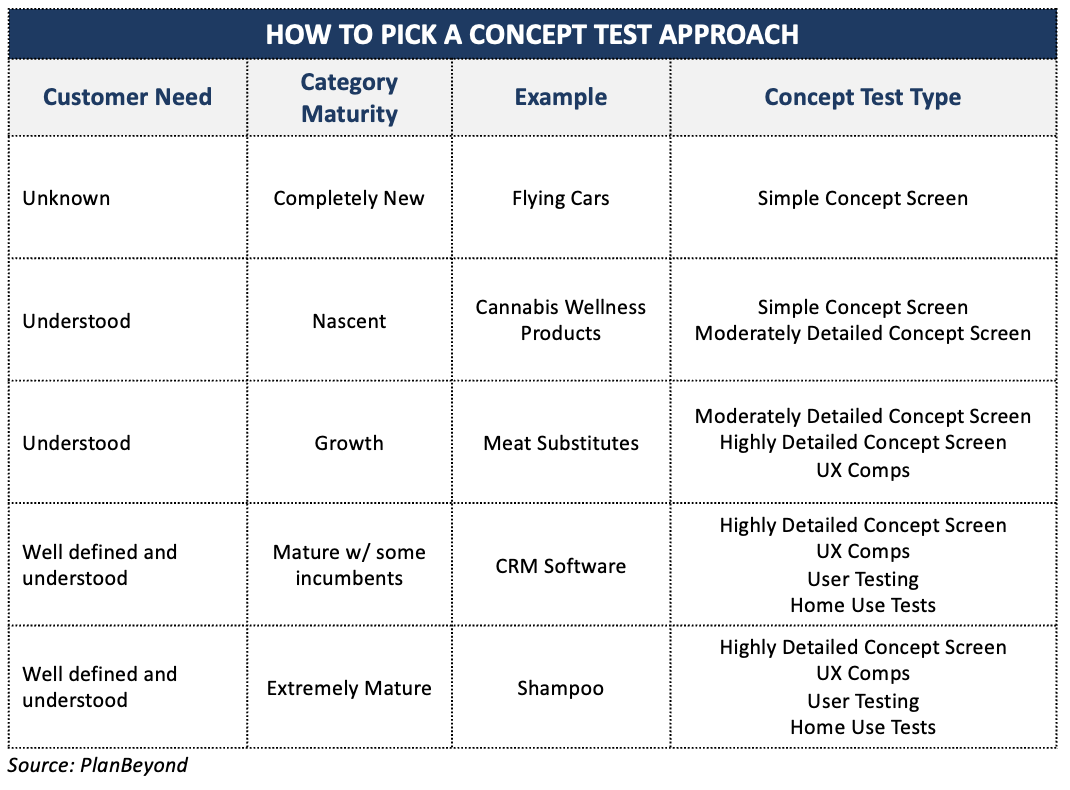Smart business leaders understand that a product or feature idea isn’t good just because it seems like a good idea. It takes input from customers or prospective users to truly evaluate its quality and worth. This extra step is vital to avoid being one of the 95% of new products that fail every year.
How do you vet a product idea and get input? It depends.
By assessing how well understood the product category and customer need is, you’ll have the foundations you need to jump into idea testing.
Understanding Different Types Of Product Vetting Options
Our intro circled around the real topic at hand: product concept tests. Any work done to vet a product idea is a product test. However, product tests take a variety of forms.
Let’s start first with discussing the different ways that we do product or concept tests. We can then back into when each one is an appropriate choice.
- Simple Concept Screen: Usually a straightforward series of sentences. This includes a very basic description of what the product does, the challenges it addresses, and the benefits you’ll get from using it. Aim for no more than four sentences. There are no images, no price points, and usually no branding.
- Moderately Detailed Concept Screen: This option expands on the simple concept screen. It may include incremental feature ideas, a rough visual comp, or more detailed benefits. Moderately detailed screens assume those evaluating them understand the category and therefore would be looking for more information.
- Highly Detailed Concept Screen: This option builds on the moderately detailed approach. It may include multiple product images, labels, or screenshots. You will see very tangible benefits gleaned from trialist testimonials, case studies, or clinical tests. It assumes a very experienced user who needs a lot of information to make an assessment.
- UX Comps: UX comps take someone through the product user experience. As the most basic level, this includes product wireframes. In more built-out versions, you may see user flows or journeys and product mockups. Common in software products, it helps potential users get a sense for the product experience and see if it meets their needs and expectations.
- User Testing: As the name implies, this refers to individuals actually using and engaging with the product. The name itself tends to be used more in software categories where you can watch individuals actually engage with the software and see their actions live.
- Home Use Tests: A home use test is really a subset of user testing. Specifically, it refers to tests done in customers’ homes or other physical environments. It lets them take their time, use the product “in the wild,” and see if they like it. More common in CPG categories, it allows consumers to keep journals or notes about their experience so you can see if experiences track to expectations.
As you can see, this is quite a wide variety of ways to vet a product idea. How then do you decide which one to use? As you’ll see below, we take into account customer and industry factors to make that decision.
When To Use Each Product Vetting Options
Ready to see which product vetting options we should use?
It starts by understanding the broader business context — customer need and category maturity — to select the right option.
Identifying The Business Context
Look at the table to the right. You’ll see the first two columns, customer need and category maturity, define our business context. By understanding this context, we can home in on what type of test is appropriate.
- Customer Need: When we say customer need, we’re really looking at how well the need is understood and how well we can define it. For very early ideas, usually this is unknown or somewhat understood. However, as you’ll see in a moment, as category maturity grows, customer needs becomes better known and understood too.
- Category Maturity: Category maturity refers to a category’s life stage. Some categories are so new that people don’t even understand them very well. For example, smart phones in the days of the original Blackberry. As product entrants grow, categories become more mature. And, over time, as every potential customer engages with the category, it achieves full saturation.
As you’ve likely begun to see, category maturity and customer need tend to go hand-in-hand. As need becomes better understood, market maturity grows too.

Tie Business Context To How You Vet Your Product
Let’s see how this all comes together.
Simplify Product Concept Tests When You Know Less
When you have a completely new category and don’t fully understand customer needs, you don’t want to spend needless time with brilliantly flushed out product ideas. And, you certainly don’t want to get ahead of yourself and build it. This is why simple or moderately detailed concept tests are ideal at this stage. You share just enough information to see if you pique customers’ interest without making too much of an investment.
Invest More In Product Concept Tests When You Know More
As categories become more mature, customers not only have pre-existing perceptions but you have a stronger idea for what they want. This means simple concept tests just won’t cut it. People will expect more to help them evaluate if the product makes sense for them. At this stage, investing in rough mock ups or giving customers information like pricing and tangible benefits makes sense. It aligns to their expectations and will let you know if it helps you stand out from existing category products.
Invest In Tangible Concept Experience When You Know A Lot
As we move up the chain in terms of category maturity and known customer needs, it’s necessary to invest in more tangible product tests. This can mean trying out a programmed software tool or taking a product home to try out. Customer expectations at this stage will be very high, with many customers having long-established favorites. Giving them a chance to really test out the product will let them “kick the tires” and see if it would replace or supplement something they already use.
How To Execute Your Product Or Concept Test
Once you know what type of test to run to vet your product idea, you now need to actually execute the market research. To do this, you have two options: qualitative or quantitative concept tests.
While there’s no right or wrong answer, we use a simple rule of thumb:
The simpler the concept test, the more concepts you can run through. This lends itself to quantitative methods. You can run concepts by a lot of people in a short span of time. By doing so, you get quick reads by consumers to see what sinks and what swims.
The more complex the concept test, the fewer you can run through. This tends to skew more towards qualitative methods. Because you want respondents to do more (e.g. spend time trying the product) and you want to get nuanced feedback, you can’t run the tests with too many people. The costs would be prohibitive. As a result, qualitative methods let you get deep feedback without breaking the bank.






